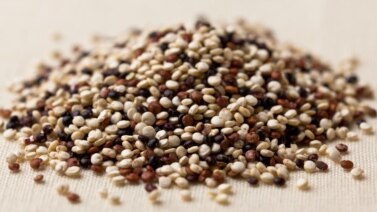
Hello and welcome to As It Is. I’m Jonathan Evans in Washington.
On our program today, we have two reports on agriculture. A new program in the state of Maryland is helping first-time farmers start their businesses. We will tell you more about the program later in the show. But first, our agriculture reporter Milagros Ardin tells about how researchers are finding new ways to fight weeds.
Researchers Look for Non-Traditional Ways to Fight Weeds
Too much use of an important chemical can fuel the spread of new weeds. Some weeds are strong enough to resist weed-killing products, also known as herbicides. But researchers are finding natural ways to deal with unwanted plants.
During the harvest at the United States Department of Agriculture’s research station, just north of Washington, DC, scientist Steven Mirsky walks through a field of dry corn in search of enemies. The sight of some of those enemies causes him to cry out, “Look at the size of these pigweed plants right here.”
The plants are more than two meters tall. They have taken water, nutrients and light from nearby crops. Pigweed can quickly get out of control. Each plant can produce up to 500 thousand seeds.
Many farmers control pigweed and other problem plants by growing genetically modified crops. Such crops do not react to the effects of a weed-killing product called Roundup. Farmers can treat their fields with Roundup and kill the weeds. But the chemical does not harm the crop.
Steven Mirsky, however, notes that some crops may be resisting the treatment.
“That system works and it works well. But the repeated application ((use of herbicide)) has the potential to cause resistance. We’re certainly seeing resistance on the rise throughout the country.”
He says cotton growers in the southeastern US have pigweed that resists Roundup.
Steven Mirsky and others are studying another possibility: controlling weeds with plants instead of chemical products. In autumn, they cover the ground with what farmers call a “cover crop”, like rye. Through the spring, they let it grow until reaches a height of nearly two meters. But they do not harvest it. Instead, they roll it flat.
“We can kill this of crop without using any chemicals. And we can get a nice, sweet suppressive mulch.”
He separates several centimeters of plant material to get to the cool earth.
“And by keeping the ground cooler, it also inhibits the germination of weeds.”
A machine cuts through the protective mat to plant the crop. It grows through the summer.
Steven Mirsky says rolling cover crops do more than just fight weeds. The plants pushed down in the spring break up and become rich soil. That means better harvests in the fall.
Farmers across the country like the idea. Mr. Mirsky says it could greatly increase production of organic crops grown without the use of herbicides. He says the method will not work everywhere. But where it succeeds, it offers farmers a new tool to crush an old enemy.
And that’s the Agriculture Report from VOA Learning English. I’m Milagros Ardin.
And I’m Jonathan Evans. You are listening to As It Is from VOA Learning English.
The United States is one of the world’s leading agricultural powers. But few Americans are farmers. Agriculture reporter Bob Doughty tells us how Maryland is helping new farmers.
Government Program in Maryland Helps New Farmers
One recent study showed just two percent of the population with a job in agriculture. Yet small farms seem to be appearing in many areas to meet a growing demand for locally produced food. The people operating these farms often have little or no experience in farming.
Mark Mills once worked as a pastry chef. He decided to leave his secure job and turn to farming. He says his decision was based on two things: a strong interest in agriculture and his ignorance about what it takes to be a farmer. Mark Mills was a history major in college. All he knows about producing food comes from growing plants in his home garden and 26 years of working in restaurants. So why did he become a farmer?
“Well, it’s beautiful. Why wouldn’t you want to come to work here? I’m my own boss. But really, it’s my love of food.”
In recent years, many Americans have developed a taste for fresh, locally grown fruits and vegetables. The number of farmer's markets has increased over 50 percent in the past 10 years.
Federal, state and local governments believe now is the time to create jobs and new businesses. Mark Mills was one of four people accepted in the New Farmer Pilot Project in Montgomery County, Maryland. Sarah Miller works with the local Department of Economic Development. She says the program has worked better than many people expected.
“Boy, we didn’t even know how many we would get. We thought maybe one or two would be great. But I don’t think that we expected four.”
The project provides the new farmers with specialized business training, like marketing and business planning.
“Well, they provided the connection with the landowner, so I could actually have the land to farm on, which is key…. Then, certainly, they provided the financing for the deer fence and the irrigation, some basic things to get going.”
The program links the new farmer with an experienced one. For Mark Mills, that person is Woody Woodroof. He works at the Red Wiggler Farm in Maryland.
“The big thing to work with him on now is season extension: helping him to do the things that will allow him to harvest crops deeper into the fall and early winter.”
Mr. Mills' first year in farming was successful. He produced about 450 kilograms of turnips, 90 kilograms of carrots, and 130 kilograms of green, leafy vegetables. The hardest part was not growing the crops, he says. The problem has been selling them.
Mr. Mills says his farm probably lost more money than it earned. Luckily, his wife has a non-farm job and can provide financial support, at least for now.
Experts say many new farmers need to support themselves with another source of income.
I’m Bob Doughty.
And that’s our program for today. Be sure to tune in tomorrow for another edition of As It Is. I’m Jonathan Evans. Thank you for listening.





